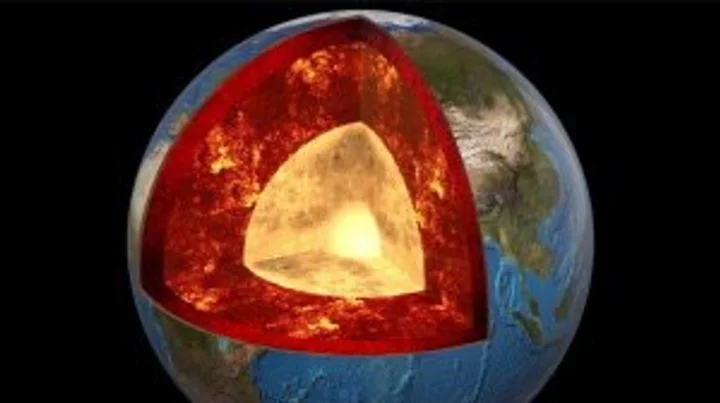
Climate Protesters Block Oil Executives From London Event
Hundreds of protesters are causing havoc outside a London hotel, blocking several top oil executives from entering to
2023-10-17 19:15

Energy Latest: Thunberg Leads Protests at London Event
Anti fossil-fuel protesters led by Greta Thunberg are blocking oil executives from entering the annual Energy Intelligence Forum
2023-10-17 18:55

The Earth is being polluted by space junk, scientists discover
Minuscule traces of metal from space junk that's designed to be disposable are invisibly polluting the Earth's atmosphere, a new study has found. In recent times, spacecrafts launched into space have been designed so that they fall out of orbit and fall back down to Earth after their intended use. So instead of the materials crashing on land, they can burn up in the upper atmosphere. Although the debris of rockets and satellites burn up when re-entering the planet's atmosphere, the consequences of metal vapour being left behind currently remain unknown. But given the amount of space exploration taking place, the amount of metal vapour is expected to rise in the years to come. Physicist Daniel Murphy of the National Oceanic and Atmospheric Administration (NOAA) has led a team of researchers to investigate what effects this metal vapour could have as well as its impact over time and this study was published in Proceedings of the National Academy of Sciences, as per Science Alert. He listed "iron, silicon, and magnesium from the natural meteoric source" as the current refractory material in stratospheric particular. Murphy has warned how this composition could be affected by the metal vapour from space junk. "However, the amount of material from the reentry of upper-stage rockets and satellites is projected to increase dramatically in the next 10 to 30 years," he wrote. "As a result, the amount of aluminum in stratospheric sulfuric acid particles is expected to become comparable to or even exceed the amount of meteoric iron, with unknown consequences for inclusions and ice nucleation." To find out if metal vapour remained, Murphy and his team took and analyzed 500,000 stratospheric aerosol droplet samples to see if they had traces of spacecraft metals. Aerosols contain sulfuric acid droplets made from the oxidation of the carbonyl sulfide gas and in the atmosphere, this can appear naturally or as a pollutant. Metal and silicon traces can be found in these droplets too, acquired from meteors which vaporize upon atmospheric entry. Around 20 metals were discovered from this research, and while some metals had similar ratios to the vaporizing meteors, other metals such as lithium, aluminium, copper, and lead exceeded the anticipated amounts. Particles from vaporized spacecraft were found in 10 per cent of stratospheric aerosols over a certain size while other common spacecraft metals such as niobium and hafnium were also present. Consequently, these traces of spacecraft particles could affect how water freezes into ice in the stratosphere, and stratospheric aerosol particles could change in size. Due to more space exploration planned in an "era of rapid growth" for the industry, the researchers predict "the percentage of stratospheric sulfuric acid particles that contain aluminum and other metals from satellite reentry will be comparable to the roughly 50 per cent that now contain meteoric metals." Sign up to our free Indy100 weekly newsletter Have your say in our news democracy. Click the upvote icon at the top of the page to help raise this article through the indy100 rankings.
2023-10-17 18:50

Russia fines Zoom $1.18 million for operating without local office -RIA
MOSCOW A Russian court on Tuesday fined Zoom Video Communications 115 million roubles ($1.18 million) for operating without
2023-10-17 18:46

Nukefluencers Are On a Quest to Push Clean Power From Reactors
Let’s meet the newest generation of nuclear activists. There’s a Brazilian model. Miss America. A nonprofit founder who
2023-10-17 18:45

A parasitic wasp with a giant head has been discovered and it's the stuff of nightmares
Scientists have unearthed a new species of wasp in the Amazon – and it's rather terrifying. The alien-looking parasitic creature came to light when a team at Utah State University were researching Allpahuayo-Mishana National Reserve in Peru. The wasp, known as Capitojoppa amazonica, has a giant almond-shaped head and is known to latch on to prey before sucking its blood and then eating it from the inside. It does so by laying eggs in its victims including caterpillars, beetles and spiders. The study’s lead author, biologist Brandon Claridge called the practice a "solitary endoparasitoid". "Once the host is located and mounted, the female will frantically stroke it with her antennae," Claridge told Live Science in an email. "If acceptable, the female will deposit a single egg inside the host by piercing it with her ovipositor (a tube-like, egg-laying organ)." He went on to explain that in some instances, "females will even stab the host with the ovipositor and feed without laying an egg as it helps with gaining nutrients for egg maturation." This isn't the first horrifying discovery, with researchers recently finding a new species of tarantula in Thailand that is characterised with illuminous blue legs. The spider is one of the rarest in the world, with Dr Narin Chomphuphuang explaining how it lurks in hollow trees. "The difficulty of catching an electric-blue tarantula lies in the need to climb a tree and lure it out of a complex of hollows," he explained. "During our expedition, we walked in the evening and at night during low tide, managing to collect only two of them." Sign up for our free Indy100 weekly newsletter Have your say in our news democracy. Click the upvote icon at the top of the page to help raise this article through the indy100 rankings.
2023-10-17 18:23

South Africa Says It Can Raise $60 Billion for Its Transition to Green Energy
South Africa may be able to raise as much as 1.13 trillion rand ($60 billion) over the next
2023-10-17 17:55

Adobe unveils futuristic ‘digital dress’ that changes patterns on the go
Software company Adobe unveiled a new futuristic “digital dress” that lets wearers change patterns on its surface on the fly with the click of a button. The dress, created under Adobe’s “Project Primrose”, is made of sequins which are “reflective light-diffuser modules” built using liquid crystals such as those in smart lighting. Researchers say the sequins are basically tiny screens built using smart materials. The dress was unveiled for the first time for the audience at Adobe’s MAX conference last week with the software company describing it as bringing “fabric to life”. Video from the conference showed Adobe researcher Christine Dierk wearing the strapless outfit, which appeared like an average cocktail dress on first impression, but the patterns on it begin to shift immediately with the touch of a remote button. “Unlike traditional clothing, which is static, Primrose allows me to refresh my look in a moment,” the Adobe scientist said while demonstrating that its colors can go from light to dark in a moment. The researcher-turned-model also showed that the dress not only had static changes, but also animated designs with patterns fading in and out. Ms Dierk, who not only designed the dress but also stitched it herself, demonstrated that the outfit will even respond to movement. Researchers say the dress is built using “reflective-backed polymer-dispersed liquid crystal (PDLC)” a material commonly used in smart windows. “This low-power non-emissive material can be cut to any shape, and dynamically diffuses light,” scientists wrote in a study presented at a tech conference last year, but it remains unclear how heavy the dress can actually get. “Designers can layer this technology into clothing, furniture, and other surfaces to unlock infinite style possibilities – such as the ability to download and wear the latest design from a favorite designer,” Adobe noted. They said the high-tech sequins are also used for smaller products part of Project Primrose including a handbag and a canvas. “We hope this work inspires future designers of flexible displays,” scientists said. Read More Photo giant Getty took a leading AI image-maker to court. Now it's also embracing the technology John Warnock, who helped invent the PDF and co-founded Adobe Systems, dies at age 82 In closed forum, tech titans to give senators advice on artificial intelligence Tell us if you think price is the biggest problem with electric cars Sadiq Khan, Met Commissioner to ask phone companies to ‘design out’ theft TikTok details plans for Israel-Hamas war posts
2023-10-17 17:51

Amazon to launch online shopping service in South Africa in 2024
JOHANNESBURG (Reuters) -U.S. ecommerce firm Amazon said on Tuesday it would launch its online shopping service in South Africa in
2023-10-17 16:59

These Stocks Are Moving the Most Today: J&J, Bank of America, Goldman, Lockheed, Ericsson, NetScout, and More
Johnson & Johnson, Bank of America, and Goldman Sachs are scheduled to report third-quarter earnings on Tuesday, Ericsson slumps after withdrawing margin guidance, and NetScout reduces its outlook for fiscal 2024.
2023-10-17 16:51

Tesla to recall nearly 55,000 Model X vehicles, auto regulator says
The U.S. auto regulator on Tuesday said Tesla will recall 54,676 Model X vehicles manufactured between 2021-2023, as
2023-10-17 16:18

Scientists have discovered two giant mystery structures lurking under Africa
Many of us look to the stars for answers to life’s most complex questions. But actually, some of the greatest mysteries lie beneath our very feet. One might think we’d know the Earth pretty well by now but, in fact, our planet’s core remains shrouded in enigma. Indeed, there are two gigantic blobs located beneath Africa and the Pacific Ocean that occupy around six per cent of the world’s entire volume. And yet, we’re still not entirely sure what they’re made of or where they came from. There are a number of hypotheses, including that they are piles of oceanic crust that have accumulated over billions of years. Sign up for our free Indy100 weekly newsletter But a more interesting theory is that they are huge chunks of an ancient planet that hit the Earth around 4.5 billion years ago. To give an indication of just how massive these things are, the structure under Africa – an area known as Tuzo – is thought to be around 800km (497 miles) tall – the equivalent of some 90 Mount Everests stacked on top of one another, as IFLScience notes. The problem with determining the origin of these monster formations is that there are no direct ways of observing the Earth’s core. The deepest hole humans have ever dug – branded the "entrance to hell" – reached a pretty staggering 12,263m (40,230ft), but that doesn’t even come close to breaking through the crust to the layers beneath. Our most effective tool for analysing what lies beneath the ground is a technique called seismic tomography, which looks at how waves of energy travel when earthquakes occur. Since rocks and liquids have different densities, the waves move through them at different speeds. By measuring the tremors from different points on the surface, geologists can determine what kind of material the waves are travelling through and, in so doing, map out the Earth’s interior. It was by using this technique that the two unusual structures – known as large low shear velocity provinces (LLSVPs) – were found. Waves travel more slowly in these areas – fondly known as “blobs” – than through the surrounding lower mantle, indicating that they’re made of something different. We can’t tell what this material is based on seismic tomography data alone, but some scientists like to believe that they are the remnants of an ancient planet called Theia – an idea known as the “giant impact hypothesis”. According to this hypothesis, around 4.5 billion years ago, a Mars-sized object collided with the Earth. This impact not only created the planet we call home today, but also threw off enough rock to form the moon that lights up our night skies. Some scientists suggest that some of Theia’s leftovers also sunk to the bottom of the planet, probably settling somewhere above the core – thereby forming at least one of the two LLSVPs. More Updates About Strange Blob Structures Inside Planet Earth youtu.be Experts have been investigating the area for decades but there’s still no way of knowing for sure just what these two giant blobs are. Still, studies into Theia have offered important insights into how the possible collision might have kickstarted key plate tectonic and mantle motion inside our planet – crucial processes for establishing the world on which we live. It’s also a useful reminder that we still have so much to learn about our planet and where we came from. Have your say in our news democracy. Click the upvote icon at the top of the page to help raise this article through the indy100 rankings.
2023-10-17 14:56
You Might Like...

Does Microsoft own the letter 'X' trademark?

Distinctive Workforce Solutions, Distinctive Personnel, and ManageRight Technologies Unite as SourceNow, Disrupting the Staffing Industry

Mac Studio 2023 First Look: Small Chassis, Massive M2 Power

Thousands of Reddit communities go dark to boycott third-party app charges

Does Your Airbnb Have Hidden Cameras? Here's How to Check

Job Cuts Are Mounting This Earnings Season. It’s a Warning for the Economy.

US, China Vie for Influence at Upcoming Pacific Forum, With Climate Change in Focus

How to Get F1 Manager 2023 Early Access
